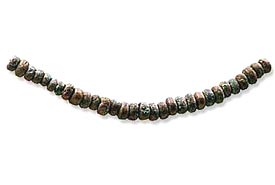Copper Jewelry in the Early Americas
 Early copper beads
Early copper beadsPhotograph courtesy of the Ohio Historical Society
Before the little blue box, woman during the times of early America dreamed in copper. According to Annette Brown, of Native American descent from the Cherokee, Shawnee and Creek tribes, and owner of Native American Expressions, in Alvin, Texas, American Native Indians traded copper jewelry.
"People traveled trade routes, which is how copper arrived in the North," she explains. "Most of the artifacts were formed in the Latin area with the Aztecs, Mayas, and Inca's. Then, the French arrived and traded copper or brass beads with Northern American Indians like the Iroquois, Sioux and Cheyenne. However, the Inca's, who live in the mountains of Peru, create my pieces, like mixed metal copper braided bracelets that have been melted down with brass and iron, as well as copper."
Crazy Crow Trading Post opened an Indian store in Dallas, Texas, to serve the local community in 1973. They've grown from a single table at a powwow to a modern 31,000 sq. ft. warehouse complex with offices.
"Even though Indians had copper before European contact, they've made little use of it except for occasional jewelry items," explains Barry Hardin, sales manager. "Archeological evidence apparently shows that after European contact they both traded for and made brass bracelets from heavy gauge brass wire, concurrent with their use of copper. Many times copper and brass materials were salvaged from manufactured trade goods like brass kettles and pails. Among the over 7,000 products we carry, Crazy Crow deals in reproductions of brass and copper wire bracelets like those used by native Americans during the 1800s and earlier. Regarding the beads, I'm sure that any attempts by Indians to fashion beads from copper was, at best, sparse. Indians were never interested in making items from mineral material. They were Stone Age people and their handicrafts used simple natural materials such as plant and animal byproducts. Indians only became involved with mining after they were enslaved by the Spanish and forced to dig for silver, especially in South America."
Lee Anderson, the founder and one of the owners of Americana Indian Shows, together with his sons, Eric and Matthew, continues a business and tradition started nearly forty years ago. He has penned many papers on Native American Indians and is a credited appraiser of Southwestern Indian jewelry, Kachinas, rugs, baskets, pottery and artifacts. They had galleries in Sedona and Flagstaff, Arizona, but closed them and now travel around the country with approximately 26 shows and sales a year.
"The Navajo wore ornaments obtained from those they conquered and trading partners, as well," says Anderson. "The ornaments were made from German silver, which was a copper/nickel/zinc substance, as well as copper, brass and some silver. They learned to appreciate and hold dear the symbols of their prowess or their wealth."
According to Anderson, the early Navajos wore a cross or a crescent shaped naja on a rawhide necklace, which was likely an ornament of beauty and pride. Thus, the pendant cross evolved, as did the naja, into a multitude of variations and blends. They were displayed on a simple thong and included metal beads, stone, shell or silver. And, the Zuni were skilled craftsman also creating items in copper, brass and iron.
Also in this Issue:
- Copper Art Shines in the Garden
- Massey Copper: Inspired by the Organic Form
- The Sky's the Limit for Celestial Copper Artist Phil Gauthier
- Copper Jewelry in the Early Americas
- The Five Elements: Group Sculpture Exhibition Opens at Ch'i Contemporary Fine Art
